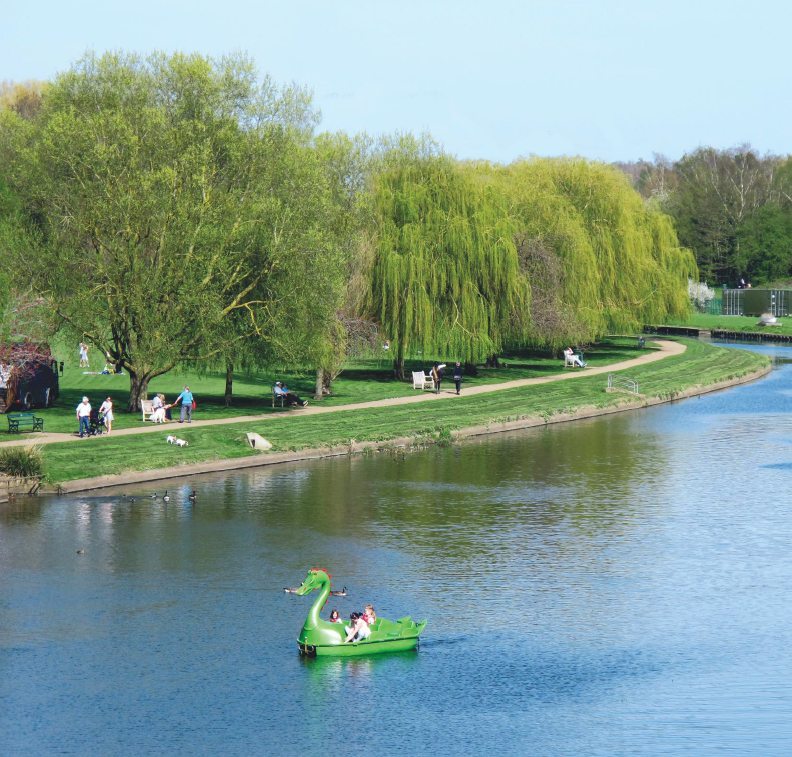
Waterway wandering through Shakespeare Country to the Cotswolds

Siân Ellis
“… such waters as these are for dreaming on in the full flush of summer, for catching the moods of summer skies, or doubling the splendour of autumn woods; for reflecting the ruddy glow of brick bridges, the moist and lichen-covered walls of old brick mills”
Rummaging in a second-hand bookshop (a favorite pastime of mine), I once came across a tome from 1909 called The Rivers and Streams of England, by author/historian A. G. Bradley. It fell open and the above description tumbled out; it has echoed with me ever since.
Rivers: they mirror and transform life around them, re-casting it as pale, wavering ephemera or still, deep spectres enriched beyond the here and now. Flowing through time and place, they are the thread of history and travel: their watersides the ideal places for settlement, boundaries with bridging points to be won or lost, arteries for communication and commerce or pageant and leisure. What better thread to pick up for a tour?
Take the Avon, one of my favorite waterways. You’ll find Avons all around the country—the name derives from the old Brythonic abona meaning river—but my “River River” is the Warwickshire or Shakespeare’s Avon. Running nearly 100 miles on a south-westerly course from Naseby in Northamptonshire, via Warwick, Stratford, Evesham and Pershore to Tewkesbury on the edge of the Cotswolds, it’s sheer liquid history and poetry: gathering along its banks three decisive English battles, the nation’s greatest bard, time-warp medieval and Tudor townscapes, and countryside famous for blossom and fruit. Quintessential England for dreaming on.
[caption id="" align="aligncenter" width="538"]

Siân Ellis
Whether boating, walking or dipping in and out of riverside scenes by car, here’s my Avon. I admit that its source, Naseby, is for battle aficionados rather than general travelers, and central England has always provided good turf for settling scores. Leaving aside the spring near the village that is the infant river, there’s a battlefield trail to follow to key sites in the 1645 clash that saw Parliament’s New Model Army rout Charles I’s main field army. Hastening the end of the first instalment of the Civil War, Naseby provided a substantial steppingstone on the long path to taming the monarchy.
Flexing its muscles and flirting with the Grand Union Canal, the Avon then heads for Rugby, where, in the eponymous public school, the game of rugby was invented—take a tour and also hear about former pupils like World War I poet Rupert Brooke. Incidentally, my “river man” A. G. Bradley was a native of the town. Maybe there’s something in the water, because a few miles downriver Stoneleigh Abbey provided Jane Austen with literary inspiration, too: for the character of Anne Elliot in Persuasion and descriptions of Sotherton Court in Mansfield Park.
Several river loops further on, Warwick is where, for me, the Avon comes into its own. The town was founded in the 10th century as a defence against Danish invaders, on a hill overlooking and controlling the river valley. Parking at waterside St. Nicholas Park, you’re immediately in the right place to hire a boat or pedalo in the shape of a dragon or swan, the fun way to float along to Warwick’s magnificent medieval castle, whose story was told by our esteemed editor in British Heritage, November 2014.
The “Swan of Avon” (the nickname Ben Jonson gave to Shakespeare) would surely approve of such waterborne theatrics. Traveling solo, however, I eschewed the pedalo in favor of the foot to explore: including a puff up 160 steps of the tower of the Collegiate Church of St. Mary, which, if you survive, gives superb views over castle and town.
Both castle and Shakespeare tell the tale of the Earl of Warwick, Richard Neville, “Thou setter-up and plucker-down of kings” (Henry VI, Part III), who helped Edward IV onto and off the throne in the 15th-century Wars of the Roses; you’ll also find Neville’s effigy and tombs of his relatives in St. Mary’s ornate Beauchamp Chapel. “The Kingmaker, as he was known, is the miserable-looking fellow,” church guide Patrick Littlejohns cheerfully pointed out.
Although a Great Fire of 1694 destroyed much of Warwick’s eminently walkable medieval core, beautiful buildings like 14th/15th-century timber-framed Lord Leycester Hospital, a rest home for retired servicemen, remain, joined by handsome 17th/18th-century edifices: creating a wonderful contrast between tipsy, leaning black-and-white buildings and fine upstanding redbrick denizens.
[caption id="FlowGentlySweetAvon_img3" align="aligncenter" width="557"]
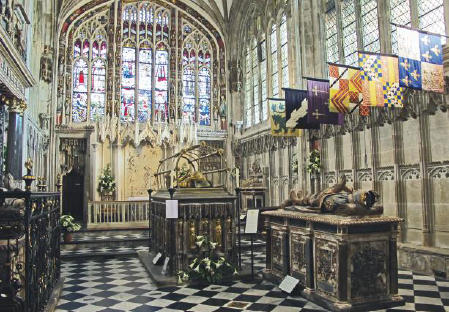
Siân Ellis
Charlecote Park, home of the Lucy family for more than 800 years, overlooks the Avon on the edge of Stratford and is famous for another clash of styles: a scallywag young William Shakespeare is alleged to have been caught poaching deer here and was hauled up before the local magistrate, coincidentally Sir Thomas Lucy. The Bard later punctured authority with the pen, ridiculing Lucy as fussy Justice Shallow in The Merry Wives of Windsor and Henry IV, Part II.
Today, the deer still roam, the tall chimneys and mellow brickwork of Charlecote’s house conjure up Tudor England, and peaceful views from the parterre follow the Avon to the pretty village of Hampton Lucy. There you’ll find redbrick Charlecote watermill, behind a fringe of weeping willows, grinding four on a site that goes back centuries. At the time of the Domesday survey there were more than 600 working watermills in the Warwick area; alas no more.
[caption id="FlowGentlySweetAvon_img4" align="aligncenter" width="424"]

Siân Ellis
[caption id="FlowGentlySweetAvon_img5" align="aligncenter" width="414"]
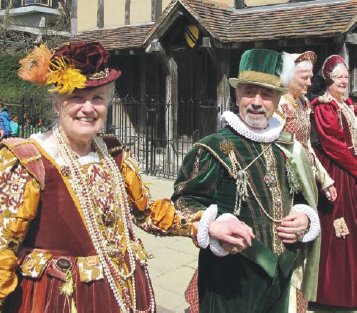
Siân Ellis
[caption id="FlowGentlySweetAvon_img6" align="aligncenter" width="451"]

Siân Ellis
[caption id="FlowGentlySweetAvon_img7" align="aligncenter" width="589"]
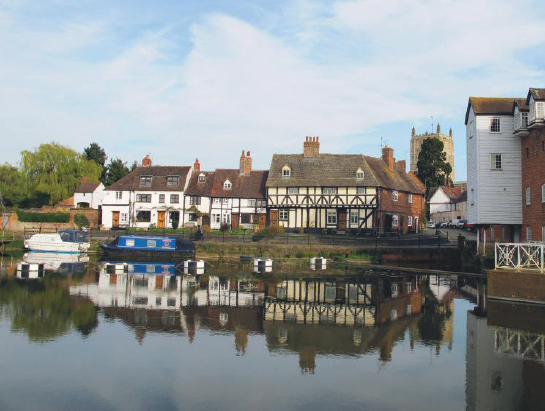
Siân Ellis
[caption id="FlowGentlySweetAvon_img8" align="aligncenter" width="298"]
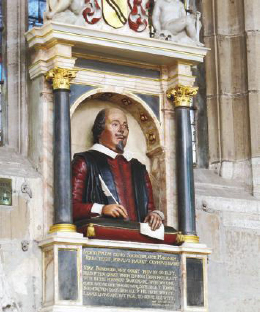
Siân Ellis
[caption id="FlowGentlySweetAvon_img9" align="aligncenter" width="287"]

Siân Ellis
Mill sites became focal points for locks and sluices when schemes to make the Avon navigable between Stratford and Tewkesbury got underway from the 1630s. There were plans to make Stratford—the name means “street ford” as a Roman road once crossed the river—a great river port with links from the Avon via the River Severn to Bristol and the rest of the world; the arrival of Stratford’s 19th-century canal connecting river and town with Birmingham also boosted cargoes of industrial goods. But decline set in as the railway revolution took off and boating today is for out-and-out leisure. The main business in town, however, is the Bard, his birthplace and family homes.
You can do the river on a cruise with a commentary or cream tea; a gondola trip followed by a performance at the Royal Shakespeare Theatre is memorable; and I enjoy the immersion in period-costumed throngs at the annual Shakespeare Birthday Celebrations in April and the color of the River Festival in early summer. Anytime, the wordless peace of Holy Trinity Church where Shakespeare was baptized and buried—and where you’ll discover the family scandal that made him hastily alter his will—holds a particular magic for me.
For a taste of traditional English village life, I recommend nearby Welford-on-Avon, still with its maypole, picture-perfect thatched, black-and-white cottages in Boat Lane, and the flag-stoned Bell Inn, where Shakespeare is said to have supped with Ben Jonson and Michael Drayton before contracting pneumonia after a rain-soaked trudge back to Stratford. (The Bell’s food is good, from light bites to sirloin steak.) Our Will also drunkenly caroused at Bidford-on-Avon: village life, eh?
[caption id="FlowGentlySweetAvon_img10" align="aligncenter" width="474"]

Siân Ellis
Cruising on down to the market towns of Evesham and Pershore takes us into blossom and fruit country. The Battle of Evesham 1265 and Simon de Montfort’s role in furthering the cause of democracy was told in British Heritage, June/July 2015, and his memorial in Abbey Park offers a sober counterpoint to the boat trips and families at play here; Evesham also has a summer river festival. On the riverbank in Pershore, a town renowned for its Georgian architecture, I chatted to Kelvin and his red collie Sky—both recently retired and now living on a narrowboat—as they moored up for the evening. Kelvin’s new life in the slow lane sounded the perfect escape from the rat race.
Tewkesbury, where Shakespeare’s Avon flows into Edward Elgar’s Severn amid watermeadows, is a fitting finale. While the town’s heritage of boat building and mills is surpassed nowadays by the renown of its outstanding medieval streetscapes, the Battle of Tewkesbury 1471 is the most famous date in its history. The resounding Yorkist victory meant Edward IV’s throne was not seriously challenged again in the Wars of the Roses. Over the second weekend of July each year there’s a superb medieval festival and reenactment; anytime you can walk the Battle Trail (leaflets from Out of the Hat visitor center).
[caption id="FlowGentlySweetAvon_img11" align="aligncenter" width="372"]
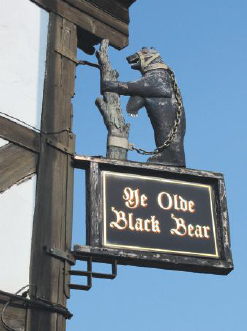
Siân Ellis
Meanwhile, over in the soaring abbey, the “Sun in Splendour” badge of Edward IV and the royal House of York looks down on the burial place of the defeated Lancastrian Edward, Prince of Wales. “Now is the winter of our discontent / Made glorious summer by this sun of York,” as Shakespeare wrote in Richard III.
The Bard, who clearly made the most of his Avon stomping ground, had Falstaff describe Poins as having “wit as thick as Tewkesbury mustard” (Henry IV, Part II); be warned, the condiment, still made as a local cottage industry, packs a kick. And it’s claimed our Will performed with a traveling troupe at Ye Olde Black Bear pub on the High Street—I had no hesitation in drinking to that after my expedition.
Go with the flow
RIVER…………………Warwickshire/Shakespeare’s Avon
SOURCE………………Naseby
FINISH…………………Tewkesbury
LENGTH……………….nearly 100 miles
TRAVELING: Take it gently by narrowboat—max speed 6 m.p.h. downstream, 4 m.p.h. upstream. The Avon is navigable for 46 miles from Alveston weir above Strat-for-dupon-Avon to Tewkesbury and there are junctions with the Stratford Canal and River Severn. Narrowboat hire information at www.starlinenarrowboats.co.uk, www.valleycruises.co.uk, www.avoncanalboathire.com. For boat trips see town websites below.
Pull on your boots to follow sections of the 88-mile Shakespeare’s Avon Way long-distance footpath that shadows the river, www.shakespearesavonway.org
EXPLORING BY CAR IS EASY; To reach the Avon at Warwick, for example, it’s around 2 hours from London (M40/A429) and both major and country roads link the riverside towns.
WHERE TO STAY: With Warwick, Stratford, Evesham, Pershore and Tewkesbury in view, there’s plenty of choice from B&B to hotel. It’s all at: www.visitwarwick.co.uk, www.visitstratforduponavon.co.uk, www.eveshamtown.co.uk, www.visitpershore and www.visittewkesbury.info.





Comments